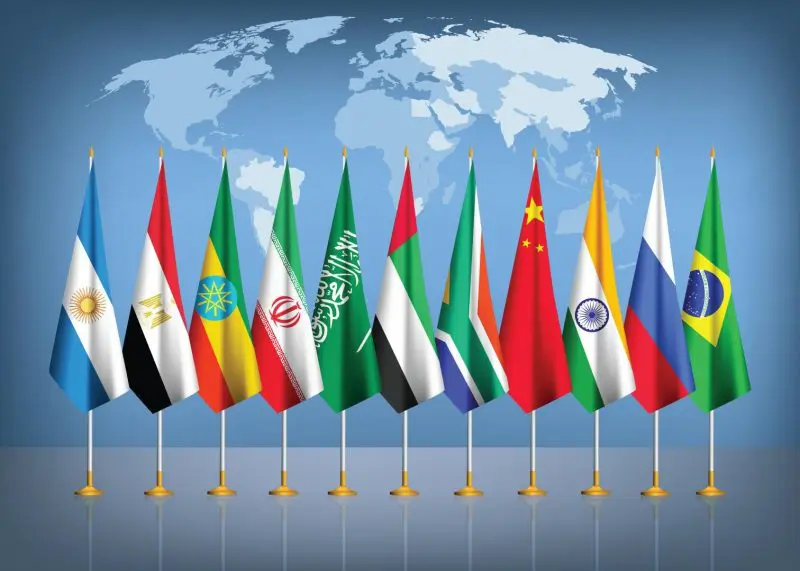Future of BRICS and India’s Leadership Role in Emerging Economies (2024–2025)
BRICS (Brazil, Russia, India, China, and South Africa) is experiencing a period of strategic transformation, marked by expansion, increasing geopolitical significance, and economic diversification. India's role within BRICS has evolved from a participant to a strategic leader, as it navigates its diplomatic and economic position amidst shifting global power structures. The developments in 2024 and the planned trajectory for 2025 signal BRICS's growing influence on global trade, finance, and political governance.
Recent Developments in BRICS (2024)
- BRICS Expansion in 2024
- In August 2024, BRICS expanded to include Saudi Arabia, Iran, the UAE, Egypt, and Ethiopia, increasing the total number of member countries to 10.
- This expansion elevated BRICS’s share of:
- Global GDP → 30%
- Global population → 47%
- Global trade → Over 25%
(Source: CFR, 2024)(Link)
- BRICS Summit 2024 (Kazan, Russia)
- The 2024 BRICS Summit was held in Kazan, Russia under the theme "Strengthening Multilateralism for Just Global Development and Security."
- Key outcomes included:
Adoption of the Kazan Declaration – Strengthened economic cooperation, sustainable development, and commitment to reducing trade barriers.
Agreement to increase trade using local currencies and reduce dependence on the US dollar.
Pledge to enhance infrastructure connectivity among BRICS countries.
Future of BRICS (2025)
- BRICS Summit 2025 (Brazil)
- The 2025 BRICS Summit will be held in Brasília, Brazil in July 2025.
- Over 100 technical and ministerial-level meetings are scheduled between February and July 2025.
- Focus areas will include:
- Strengthening trade within the bloc.
- Developing a BRICS payment network.
- Finalizing the BRICS reserve currency framework.
India’s Growing Role in BRICS
- Economic Leadership
Champion of Local Currency Trade
- India has pushed for the creation of a BRICS Reserve Currency to bypass Western-dominated financial systems.
- BRICS countries have agreed to use local currencies for bilateral trade, reducing dependency on the US dollar.
Unified Payments Interface (UPI) Expansion
- India has proposed expanding its UPI model to facilitate seamless digital payments between BRICS countries.
- This could lead to the development of a BRICS-wide payment system.
Trade and Investment Strategy
- India leads initiatives to increase trade and investment flows among BRICS countries.
- The New Development Bank (NDB), headquartered in Shanghai, is funding several infrastructure projects in India and Africa.
- Political Influence and Strategic Leadership
Bridge Between Global South and Western Powers
- India positions itself as a mediator between the West and the Global South.
- India's balanced diplomatic ties with Russia and the US enhance BRICS’s geopolitical leverage.
Defense and Security Cooperation
- India supports deeper defense collaboration within BRICS.
- Joint military exercises between BRICS countries are expected in 2025.
Reforming Global Governance
- India advocates for reforms in international institutions (e.g., UN, IMF, World Bank) to give BRICS countries greater influence.
- India's G20 presidency in 2023 enhanced its reputation as a voice for the Global South.
- Sustainable Development and Climate Action
Energy Security and Climate Financing
- India leads BRICS’s efforts to establish a Climate Resilience Fund to support developing countries.
- BRICS countries are exploring joint renewable energy projects and investment in green hydrogen.
Food Security and Agricultural Cooperation
- India is spearheading BRICS initiatives to increase agricultural productivity and ensure food security.
- BRICS countries are collaborating to create strategic food reserves.

Financial and Trade Developments
- De-Dollarization and Financial Independence
- BRICS is accelerating the shift away from the US dollar in global trade and finance.
- Trade settlements in Chinese yuan, Russian ruble, and Indian rupee have increased significantly since early 2024.
- BRICS Reserve Currency (Proposed)
- BRICS countries have agreed to explore the creation of a basket currency based on the member countries’ currencies.
- The proposed currency would rival the IMF's Special Drawing Rights (SDR)
- New Development Bank (NDB) Expansion
- The NDB has increased funding for infrastructure and sustainable development projects.
- New loan agreements totaling over $10 billion have been signed with member states since the 2024 Summit.
Challenges and Risks
- Geopolitical Rivalries
- Border disputes between India and China remain unresolved.
- Russia’s ongoing conflict with Ukraine creates political tension within BRICS.
- Economic Divergences
- Differences in economic structure and growth rates among BRICS countries pose challenges to policy coordination.
- China's dominance in trade within BRICS raises concerns about balanced economic cooperation.
- Western Sanctions and Global Financial Pressure
- Western sanctions on Russia limit BRICS's ability to expand financial and trade networks.
- Western-dominated financial institutions continue to control key global financial mechanisms.
Strategic Takeaways
- BRICS is becoming a counterweight to Western dominance in global financial and political systems.
- India's role as a tech leader and financial innovator within BRICS enhances its global strategic influence.
- The establishment of a BRICS reserve currency could challenge the US dollar's dominance in global trade.
- Geopolitical tensions and economic disparities within BRICS could undermine its cohesion and effectiveness.
BRICS’s transformation in 2024–2025 underscores a broader shift in the global balance of power. India’s growing leadership within BRICS reflects its strategic ambitions to lead the Global South while maintaining strong diplomatic ties with Western powers. The push for de-dollarization, enhanced financial cooperation, and sustainable development positions BRICS as a significant player in the emerging multipolar world order.













